#but Bruce Timm was involved in the series
Explore tagged Tumblr posts
Text
I couldn't find any screenshots of it, but one thing I love about Teen Titans is how Robin acts pretty similarly to DCAU Batman, including that eyebrow raise they do when they're confused out of their minds.

Again, I couldn't find any screenshots of Robin doing it, but I'm sure most of you know what I mean. The one eye twitching, the other raised.
I've said it before, but I just love the little things.
#and yes#i know teen titans isnt dcau canon#or at least is debated#but Bruce Timm was involved in the series#and i know he decided to remain mostly hands off#but you cant deny his influence#teen titans#teen titans show#teen titans 2003#robin#dick grayson#batman#dcau#justice league unlimited#thank you watchtower database for reminding me with that clip#i saw it and immediately thought “robin”
60 notes
·
View notes
Text
batman: caped crusader frustrates me. i've only seen 2 episodes, i like that it's a love letter to btas (which got me into batman in the first place) with bruce timm's involvement, but did we really need it? couldn't we have gotten a gritty cassandra cain batgirl series instead?

no one at dc has the guts to truly adapt cassandra cain either in live-action or animation and that sucks!!
29 notes
·
View notes
Text
I absolutely loved Batman: Caped Crusader's take on Barbara Gordon. A defense attorney working to ensure that everyone gets their fair hearing despite Gotham City being corrupt top to bottom, aiding her father's attempts to clean up the GCPD while still expressing skepticism that the PD are the answer to what ails the city. She's the Gordon who gets a hotline to Batman, which is a cool dynamic.


I've seen some people clown on Bruce Timm for aging her up, as multiple productions he's been involved in made Batgirl and Batman an item. People find that creepy, which it definitely was in BTAS but here's the thing: its only creepy because Barbara Gordon's age has been notably reduced over the years.
In Batman: The Animated Series, she was Dick Grayson's college classmate. In Batman & Robin, Barbara Wilson was a student of some kind (high school?). In The Batman (2005), Young Justice, Beware The Batman, and DC Super Hero Girls, she was a high schooler. She's of similar age to Dick Grayson everywhere these days, including the comics.
Which is wild because she was like thirty when Dick was like nineteen Pre-Crisis.
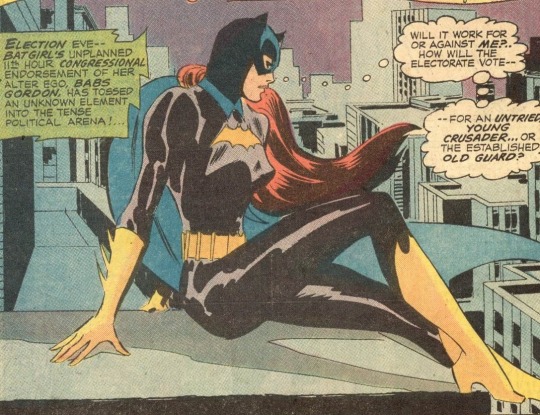
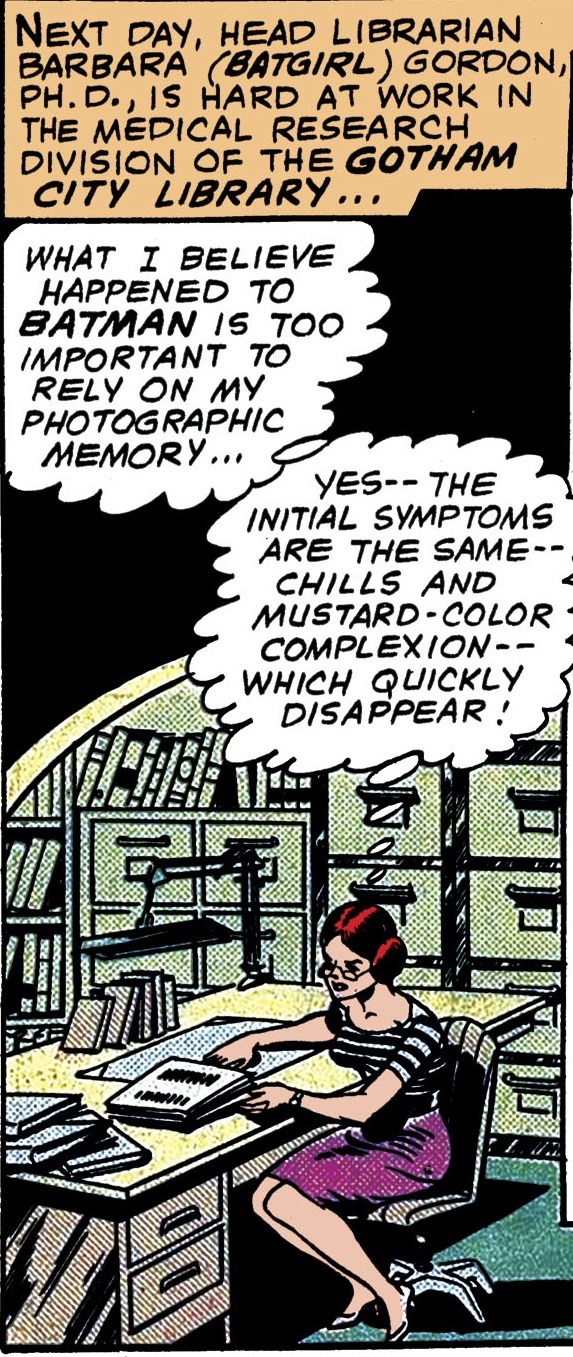
When Batgirl first appeared, she had her doctorate in library sciences. After two in-universe years worth of fighting crime, she was elected as Gotham City's U.S. Congresswoman. She briefly retired from crimefighting before deciding she could do both. She served her two year term, lost re-election, and moved back to Gotham full time. College student Dick Grayson even volunteered at one of her re-election campaign events, IIRC.
Batman even set Barbara Gordon (whose secret identity he did not know) and Clark Kent up on a date once, in the pages of Superman #268.


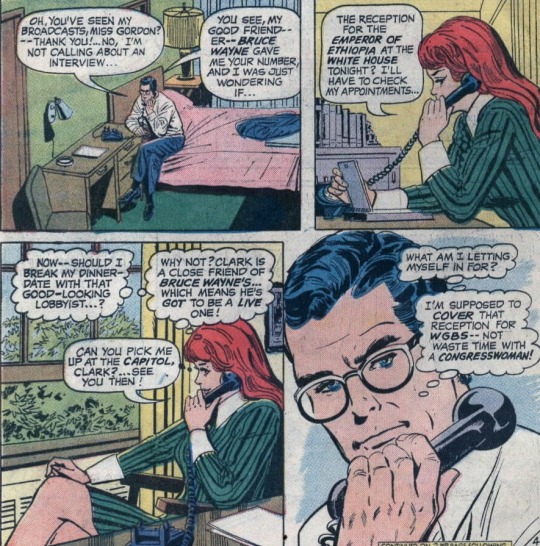
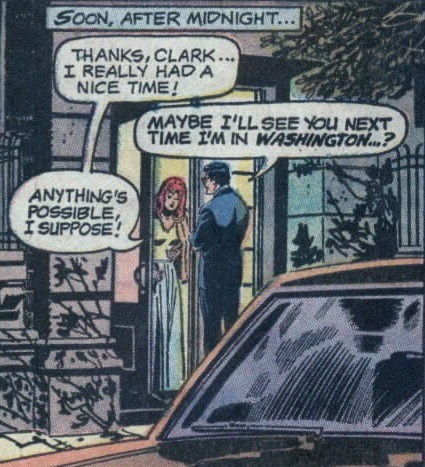
So while I get that for people in my age bracket and below, Caped Crusader ages Barbara Gordon up quite a bit, she's actually closer to the version that Bruce Timm would have grown up with.
And, personally, I find fully adult congresswoman Batgirl much more interesting than teen hero Batgirl.
#batman#dc universe#comic books#dc comics#dc characters#batgirl#batman caped crusader#barbara gordon
38 notes
·
View notes
Text
Ranking 500+ Theme Tunes - #22: Freakazoid!
You're a freakzoid! No, it's not a cartoon bully insult, it's a cartoon show! This follows wacky superhero oddjob Freakazoid, the alter ego of Dexter Douglas formed when he unlocks a secret key on his computer... or rather his cat does when he gets on the keyboard. Armed with access to all the knowledge of the internet, classic superhero strength and speed, plus seemingly some sort of Deadpool-esque fourth wall breaking. You are still a freakazoid though.

One look at this show and you can see a clear involvement of Batman: The Animated Series' Bruce Timm. One look at the writing and you can see a clear involvement of the same Warner Bros. and Spielberg team that created the likes of Animaniacs. Naturally, this is a pretty cool combination. The show heavily leans into the comedic, despite having the superhero basis to draw from. Whilst fighting bad guys and balancing the life of superhero, Freakazoid is still sure to throw in an array of meta and pop-culture references along the way.
Now I can't say that I had really heard of this show before looking into things more. This one is quite a cult classic it turns out, not performing as hoped when it originally aired but garnering a lot of love with reruns and word-of-mouth. It was first shown as part of Warner Bros. lineup, but much of its love is associated with its later run on channels like Cartoon Network. I definitely find myself enticed to watch this one from everything I've seen, as its a fun-looking show! But does the theme stack up?

Freakzoid Theme Song
A great fit of a theme song! This one is goofy, self-referential, and funny, which is a brilliant fit for the show in question. I love the off-the-wall and quick-paced catchiness of this tune. Lots of unexpected silly lines make this one extremely enjoyable, not to dismiss the great vocal performances that bring this one together. It's a theme that I often find stuck in my head and making me giggle from that alone, which is exactly what you want to hear from a comedic theme song. I don't know that it's truly transcendent, but I thoroughly enjoy hearing this one.
Being a great fit for its show, a fun and silly song, and a wonderful performance puts this one right towards the top of our tier list. This one is gonna sit extremely comfortably in A!

Stay tuned for more and be sure to send in any suggestions for other shows you'd like to see done (after the 500 already in the pipeline that is). Check out the intro to this series here, and check out the tier list.

#rating theme tunes#freakazoid#cartoons#superhero cartoons#bruce timm#steven spielberg#warner bros#cartoon network#tv#television#nostalgia#90s cartoons#90s superhero cartoons#90s warner bros#90s cartoon network#90s tv#90s television#90s nostalgia
12 notes
·
View notes
Text

Batman: The Animated Series, 103 (Sep. 7, 1992) - “Heart of Ice” [Production order #14]
Written by: Paul Dini Directed by: Bruce Timm
This is the episode where…
A subzero-themed-supervillain pursues his coldblooded thirst for revenge, against the dastardly CEO who denied his wife's healthcare. This is a great episode for kids… to learn about tragedy and grief. Enjoy!
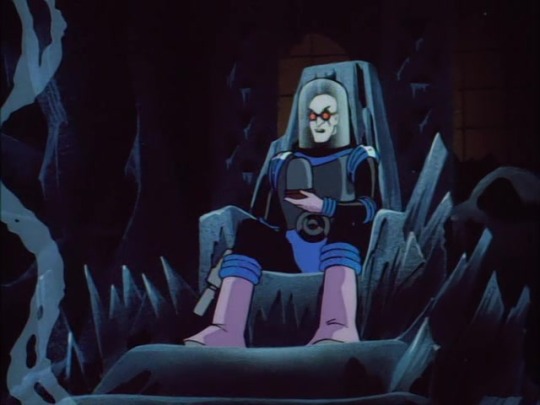

The Breakdown
Gotham wouldn’t be Gotham without another zany crime spree centered around a curiously specific motif, which in this instance is… low temperatures. That’s right, some dude using the moniker ‘Mr. Freeze’ (and wearing a full-body-cryogenic-suit) is hitting up GothCorp industries(tm) using a super-ice gun to steal a bunch of tech hardware. Since billionaires are apparently obligated to take any sort of corporate attack as a personal offense, Batman gets immediately involved, but nearly has his ass permanently handed to him.
Hoping to avoid another beat down, the Dark Knight investigates his new adversary, consequently stumbling into some very cinematically edited security footage that neatly summarizes the episode’s central conflict. The footage in question reveals that Mr. Freeze was once a humble (and notably NOT frozen) scientist named Victor “Fries” (Still pronounced ‘freeze’, though), which means that’s our cue for his tragic backstory.
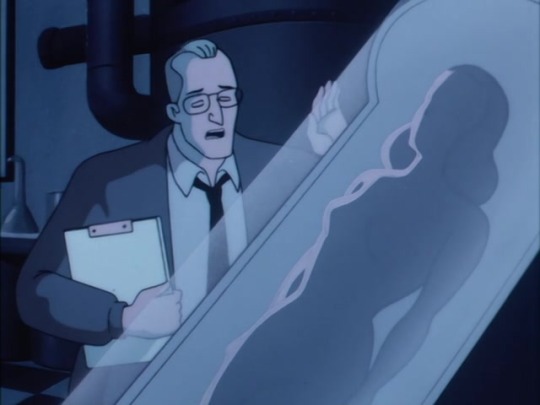


Fries’ research involved placing terminally ill people into cryostasis, so that they could be revived later when a cure was discovered; It just so happened that his wife, Nora, was his primary patient-and-test subject. The questionable ethics of this aside, it seems Nora entered into her cryogenic state with informed consent, presumably because time was running short. Unfortunately, Victor’s Boss (and head of GothCorp) Ferris Boyle became so upset over the expense of keeping Nora alive that he shut down the operation, trashing Nora’s life support functions in the process and effectively murdering her. Since this is Victor’s episode, he obviously survived the incident, but not before getting thrown into some chemicals by Boyle’s goons, consequently leaving him unable to survive outside a subzero environment (because comic books), hence the cryo-suit.
Needless to say, you can see why Victor would be acting out against the GothCorp guys, but to rub salt in the wound, Ferris Boyle is set to receive a humanitarian award at an imminent ceremony. So yeah, like, obviously Freeze is gonna fuck with that, and fuck with it he does. You see, by combining all the tech that he was stealing from GothCorp, Mr. Freeze is able to build himself a tank-sized MEGA-super-ice gun. So yeah, Freeze uses that to seal in Gotham’s elite citizenry inside a ritzy hall, during the humanitarian ceremony in question. Unfortunately, Batman intervenes mere seconds before Boyle can be turned into a human popsicle, and shatters the glass containment dome surrounding Freeze’s head, after smashing a thermos of piping hot chicken soup over it. Victory!

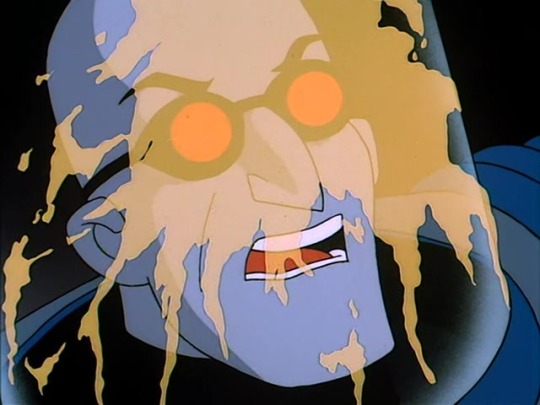

As much as Batman has strived to save Boyle from the well deserved consequences of his own systemic machinations, our hero also has a famously strict stance against overt murder. So, before heading out, the Dark Knight hands over the video evidence of Nora’s death to a reporter, while dispensing a somewhat empty platitude that essentially amounts to “justice good, revenge bad.” Anyhow, presumably Boyle is locked up, and Mr. Freeze is taken to Arkham where he sits alone in a special subzero cell, lamenting his failure to avenge his dead wife, praying in vain that she might somehow forgive him from beyond the grave.
Now, please excuse me while I search for a tissue. I seem to be having an allergic reaction to my feelings.


The Verdict
This is one of the episodes that galvanized my love of the show early on, and a quick look at the imdb rating shows that many would share my sentiments. It’s easy to take for granted as an adult, but there was something deeply cathartic about a “kids cartoon” acknowledging that sometimes there are no happy endings. We can already see a tendency for this show to dabble in shades of grey, that most children’s fare would go out of its way to avoid. Freeze’s motivations aren’t exactly charitable, but I’d be hard-pressed to say that I wouldn’t consider doing the same in his situation, and that ability to empathize with the “villain” was something my seven-year-old psyche found very existentially intriguing.
This episode also boasts more genuinely gorgeous animation. The use of shadows against contrasting light sources holds up quite nicely (Batman has never looked better sitting in front of a computer screen), and once again the visual story telling is thoughtful and deliberate. Even where some of Freeze’s dialogue is a little more ‘flowery’, the animators give the story enough room to properly capture the pathos and grief behind his facial expressions, and it really sells. To this day the image of Freeze hunched over the ballerina effigy of his wife remains one of the show’s most tragically iconic.
Great episode.
4.5 stars (out of 5)


Parting Thoughts
Bat-thermos: No, Batman doesn’t typically carry chicken soup around with him (although I wouldn't put it past the Adam West version). He’d just come down with a head cold after a fight with Freeze where he got trapped in ice, so Alfred whipped him up some soup. Although, it’s just as well that Batman never got around to having it. Any liquid that’s scalding hot to the point where it explosively shatters glass, cold or otherwise, is almost certainly unsafe for human consumption.
Fun Bat-Facts: Prior to this, Mr. Freeze was one of the many c-list gimmick villains in Batman’s roster, whose motivations were more-or-less traditionally crime focused. Paul Dini effectively reworked Freeze’s entire origin into this far more tragic storyline, which was so well received that it was soon updated for the comics as well.
Deny, Defend, Defrost: Despite all the sci-fi/fantasy elements of this episode, the most unrealistic thing here is the idea that Batman handing over video footage of a CEO denying lifesaving healthcare, would ever lead to a successful criminal conviction. After all, Ferris Boyle did have proprietary control over the technology that was keeping Nora alive, and it’s implied that Victor Fries was operating without authorization to do so. Perhaps there would be a brief “investigation”, but I have no doubt that Boyle would have been promptly acquitted and given a raise, while Victor would be discredited and branded a terrorist. Of course, this is all conjecture. It’s not like there’s a recent, and incredibly public, real-world example from which I’ve formed the basis of my conclusion.
The Ethical-Billionaire Trope: In case it wasn’t already obvious, I tend to subscribe to the idea that excessive hoarding of wealth is a pretty crummy thing to do, but (as far as fictional billionaires go) this version of Bruce Wayne is easier to stomach. He’s regularly shown to take economic action against his corrupt peers, while investing in matters ranging from environmental conservation, to welfare programs; Still, I’m betting his private-military-arsenal comes with some steep overhead expenses that could be better spent elsewhere. And I’m not trying to be disingenuous, I realize this show is just meant for to be fun, and I don’t really take it that seriously, but I can’t entirely absolve the series for partaking in what essentially amounts to diet-pro-rich propaganda. But hey! You can’t expect to enjoy a show like this without indulging in a little bit of Nietzschean Übermensch fantasy, amiright!?
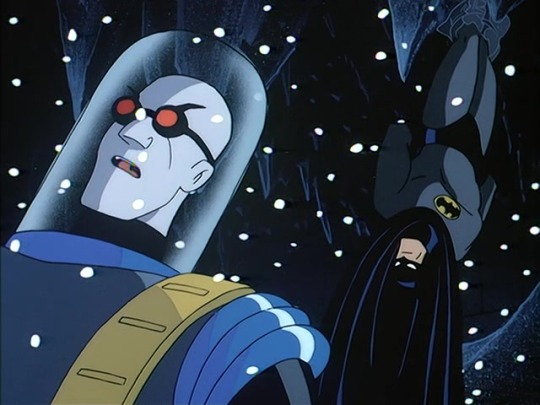
#batman the animated series#batman tas season 1#heart of ice#retro review#cartoon review#mr freeze#victor fries#nora fries#dc comics#dc animation#dc animated series#dc animated universe#90s shows#90s tv#90s tv series#90s tv shows#bruce timm#paul dini#episodic nostalgia
5 notes
·
View notes
Text
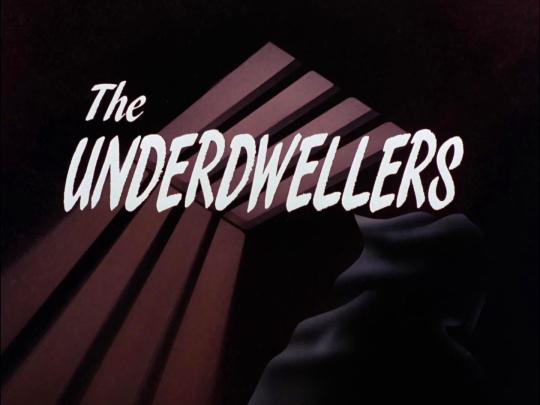
DCAU Rewatch: BTAS 6 The Underdwellers
A rash of petty crime perpetrated by children leads Batman into a clash underground when he encounters a man who fashions himself as The Sewer King.
Story by Tom Ruegger
Teleplay by J. Dennis & R. Mueller
Directed by Frank Paur
Supervising Composer Shirley Walker
Music Composed by Stu Balcomb and Lars Cutterham
Animation Services by Studio Junio
I’ve always had a soft spot for this episode. There are elements of it that strain credulity, but the concept of Batman liberating a group of orphaned children works for me thematically and this is one I have particularly vivid childhood memories of.
This is the first time I feel like the dialogue and attempts at humor in this series really work. The banter between Alfred and Bruce where Alfred encourages him to take a vacation is very funny and completely in character.
ALFRED: I do believe a break from Wayne Enterprises and crime fighting would do wonders. Perhaps a vacation? Golf?
BRUCE: Sounds boring.
ALFRED: In the Bahamas?
BRUCE: Hot and boring.
There’s a little bit of self-deprecation in the way Bruce responds, but also complete truth in it. He needs to remain busy. Boredom is too dangerous a concept for his brooding nature. Alfred trying to deal with the kid from the sewers, is full of great visual gags. All of the stuff with the boy in the mansion is great and helps round out Batman and Alfred both. It reminds us that this guy is not merely an avenging demon of the night. He cares deeply about the people he is trying to protect.
Sewer King himself is more pathetic than threatening. (Bruce Timm admitted the original script involved more overt abuse than primarily his ranting, but I think his physical cruelty is pretty well implied and I can do without it more visualized). His screaming and raving paints him as a petty little man. I do like that, though. A guy who collects and enslaves orphaned children and manipulates them into thinking they are unloved and unwanted is as pathetic as he is evil. He can’t exert power over anyone with power and so he takes out his cruel fantasies on the helpless. Someone who takes advantage of orphaned and abandoned children is a natural enemy for a man like Batman who is dedicated to protecting the innocent (and repeatedly takes in wayward children of his own).
READ THE FULL ANALYSIS AND COMMENTARY ON PATREON
2 notes
·
View notes
Text
Why Captain America

One evening two summers back (editor’s note: this post was composed back in 2010! Excelsior!), Len Lee, my friend and film director of the documentary, Tailor Made, which featured my master tailor, Bill Wong, and I considered going to film.
Len is the art house guy. I am not. I tend to fork over cash for movies involving men in tights and I’m not talking about ballet or Shakespeare. I wanted to see Captain America: First Avenger.
Len frowned. “Captain America,” he said, “I could never get into him. He seems so jingoistic.”
We settled for supper instead. But his disdain of Cap, Steve Rogers, that 1940s creation of Jack Kirby and Joe Simon, in the patriotic, Nazi-busting fervour, bothered me.
Of course, the hero’s outdated reputation arises from his origin and raison d’etre. Steve Rogers was the 98 lb weakling, stamped 4-F, and prevented from joining the army in the months just prior to America’s direct involvement in the war. He was a creation of two young Jewish men who wanted nothing better than to battle the agents of the Master Race bent on exterminating Jews.
When the war ended, when the horrors of the Holocaust came to full light, the earnestness of the star-spangled shield-slinger, the ability to knock-out evil with one right cross, seemed outlandish. Any how readers were tired of the war and therefore, they were tired of Captain America.
The superhero comic went through the lull of the 1950s. When the genre regained popularity in the Silver Age, 1960s to you non-geeks, spurned on by titles such as the Fantastic Four and Spiderman, many of the characters from the 40s were able to find new relevance in popular culture.
Unlike DC characters, the Marvel roster of characters developed in the 1940s didn’t take hold. DC’s Superman had George Reeve, Christopher Reeves and Smallville to help it maintain the character’s status as a household name the declining generations of comic readers. among non-comic book readers. Batman too has had compelling recent interpretations from Bruce Timm’s amazing animated series to Christopher Nolan’s epic gritty films to cement the caped crusader in our imagination. DC big three heroes (which includes Wonder Woman) had a lasting foothold in post-war media.
Marvel’s characters did not take hold. OG heroes like Cap, Bucky, Human Torch, and Namor, The Sub-Mariner predate Marvel Comics (Timely became Atlas which became Marvel) but disappeared once the war ended.
Yet Captain America is one of the earliest super hero creations and stands beside Batman, Superman, Wonder Woman as a true original.
And yet, at the dawn of the MCU, and despite the success of the new Cap film and The Avengers, the character, at least in 2010, felt decisively second-tier next to Iron Man and Spider-Man as a cinema star. Iron Man is hip. Spider-Man is sassy and flip as ever. Cap is simply square-jawed and square. A man out of his time.
Batman, Spider-Man, even Superman—despite his red and blue cheesiness—are acceptable, fully contemporary heroes. Somehow, they’ve entered the post-modern imagination without being two-dimensional, hokey, dated, dated, irrelevant as Captain America. Somehow they’ve lifted off the newsprint page and found a legitimate, critical place in our culture, appearing on television and cinemas. Archetypes in skin tight Underoos.
On screen, Batman had both Tim Burton AND Christoper Nolan. Spider-Man benefited from Sam Raimi AND Michael Chabon AND Kirsten Dunst.
In the comic book world, Cap remained spangle-marred until the mid-70s when social relevance entered mainstream comics.
Spider-Man had issues dedicated to combating drug use. Green Arrow and Green Lantern put aside their bow and cosmic powered ring aside and hitched a ride across America that questioned who were the real villains: super powered thieves or slum lords, racist sheriffs, and false messianic cult leaders.
Captain America did not lag behind. I started reading issues that came wrapped in a blue box and tissue paper. The storyline involved the Captain rejecting his stars and stripes and adopting the neutral blue uniform of Nomad, the man without a country. The cause: Steve Rogers discovered he was being manipulated by shadow government conspirators with a trail leading directly to the White House.
Considering that the Watergate scandal as a backdrop, the arc was mind blowing material. But that’s not what sealed the deal for me. It was how Private Rogers became Captain America again.
Those two pages were the most rousing in comic books outside of when Mar-Vell chose to leave behind the life of a Kree warrior and become a protector of peace. Those two pages have most likely defined for me the best idea of patriotism, which is about love of country and the desire to be better.
0 notes
Text
it's such a good fucking time to be a DC fan I am so excited about EVERYTHING coming up rn we got
• confirmed season 3 of MAWS
• Creature Commandos confirmed fully 2d hand drawn animation
• Batman animated series involving Bruce Timm
• confirmed animated Blue Beetle series
• James Gunn Superman
• Peacemaker season 2 (I didn't watch the first season but I'm happy it's happening anyway)
• Watchmen animated movies
WE JUST. KEEP. WINNING.
#RETURNING TO DC AS IT SHOULD BE IM SO SERIOUS#LOOK AT ALL THIS ANIMATION...ITS BEAUTIFUL#IM SO HYPED#DC FANS WE FUCKING WON#ratkingrambles#james gunn buddy pal how much do i have to pay to get my husband added to something please please please#AND technically sandman season 2 finally announced#thats technically dc right#god im so happy about all this#its SO NICE to actually be excited about dc projects fr
1 note
·
View note
Text
Might as well get this out of the way, in this hypothetical universe, here's how I'd pace it:
X-Men was hot in the 90s, so that's the first show the team does more or less out of studio mandate. Universal acclaim, dark subject matter, action and adventure. You get the idea.
Then, Bruce Timm gets to make his Fantastic Four cartoon. This is where, much like in Superman: The Animated Series, the team starts crossing over with other heroes such as Hulk, Black Panther, and Ant-Man. It's also where they start breaking into an overarching story.
Around this time, they're also getting to work on Spider-Man. Kinda a breather from the two previous team shows. Bruce Timm is very happy to dig into the Ditko-esque drama of the Spider-Man world.
then it gets a weird spin-off that nobody remembers.
Dwayne McDuffie would then make a show centred around a newly created young black superhero in the Marvel Universe. It becomes a cult classic celebrated for its diversity and tackling of social issues.
At long last, an Avengers show is created, followed up by Avengers Unlimited, both of which bring out the whole Marvel Toybox in an overarching story involving alien invasions, alternate universes, and Doctor Doom.
Alternate Universe where Warner Bros Animation made the Marvel Animated Universe in the late 90s
38 notes
·
View notes
Text
i love batman the animated series and jason todd but the two do not intersect. the only thing i liked about jason appearing in the animated series' comic universe was his design and i think that says a lot
#batman#jason todd#you can tell they only introduced him to eventually turn him into red hood#and i like red hood! i do!#but the first time b sees him hes fighting a gang in a red hoodie and hes v angry and v into batman and robin lik????#its a little too on the nose#couldnt you have let him be the bright book smart robin for a bit before he started thinking he had to be tougher on criminals?#bruce timms under the red hood movie is the only btas jason that has any rights#also they changed his backstory a lot?? to involve a brother and gang violence??#i coulve dug a brother but the characterization of everyone in that comic smh#'batman would never apologize so you arent batman!' are you sure tim???#are you sure about that btas comic writers????#meta? is this meta? (points to a shitpost)#dc comics#red hood#batman the animated series#batman gotham adventures#i think is the comic name#ok im done
16 notes
·
View notes
Text
Word salad incoming.
Something insidious about Batman is how the character often time functionally exists as an outlet for liberals to engage with the concept of the forever war. When the people that worked on comics started to be people that originally read comics and loved superheroes to such an extent that the latter became objects worth of serious study, there also came the point when comics found their new primary audience to be adults rather than children, so it was an obvious consideration, what eventually becomes of Batman? How does Batman end? And a lot of people came away from that saying, well Batman fucks up and fails because you literally can't permanently stop crime from happening.
Crime being a social construct to direct the concept of violence away from the bourgeoisie class is a post in and of itself, but for entertaining Batman as a concept, a lot of people just straight up cannot imagine a future where people aren't actively harming and killing each other. And this isn't without precedent. Superheroes are a fundamentally reactionary concept, based upon great man theory, with entire fictional universes spanning decades built around their exploits. They're not a good fit at all for actually exploring what violence is and how it manifests and, you know, the restructuring of society as a whole (which, for as much as I love superheroes to tears, is a major reason why I roll my eyes at people talking about how important they are.)
But even disregarding all of that, it reveals that a lot of people do fundamentally regard them as a farce even if they would have you believe the complete opposite. What's the point of reading and watching their exploits nonstop and being convinced that their work does good in the world if the end involves them fucking up and failing? What's the point in humoring them as a concept if it's all for not?
Batman Beyond really fucked up a looot of people's perception of the character and was a good source of "...Bruce Timm doesn't actually get it does he?" long before he had Bruce and Barbara Gordon fuck on a rooftop. What was the point in seeing the Batman of The Animated Series, most people's direct reference for the character, eventually become a disgruntled old cunt that isolated everyone else and didn't ultimately do anything to make Gotham a better place? What was the point of Scott Snyder and Greg Cepullo's Batman run in The New 52 if we just learn that Bruce literally can't make a world where Batman doesn't need to exist, he just has and endless supply of clones sitting in the wing to be Batman forever?
10 notes
·
View notes
Note
What do you think of Justice League: Gods and Monsters? Especially its version of Superman.
Of the movie in general I'm a fan. It's the only post-DCAU work from Timm that made me believe that he's got some of his old spark remaining inside.
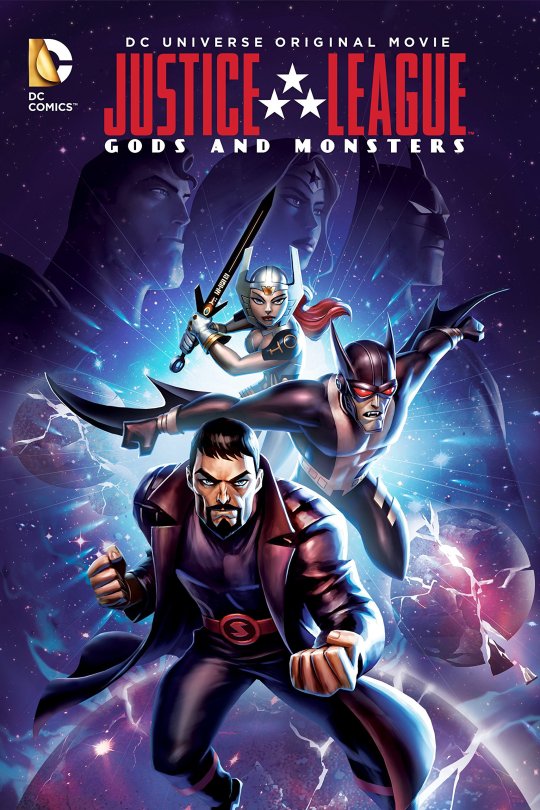
Story moves at a rapid pace so you don't get to spend as much time in this universe as I'd like. But what's there is solid and works within the timeframe given. Someone is framing the Justice League for murders of scientists, scientists who are all connected to a mysterious "Project: Fair Play". Sounds like a typical Justice League story, except this isn't your typical Justice League. Instead of the Trinity we know, here Superman is the son of Zod, Batman is a vampire, and Wonder Woman is a princess of the New Gods. Other differences abound, such as a Lex Luthor who is older and not power hungry, Amanda Waller being the President, Lois Lane not being in Superman's corner, and more. Such a shame that we never got to see this movie spun out into a full fledged animated universe the way Timm clearly was hoping, because the world building is in place to support a JL show.
Animation here is in the Timm-DCAU style and that helps the quality level markedly. Fight scenes are on par with some of the best in the DCAU, particularly the final fight at the end between Superman and the Metal Men. I'm not one for nostalgia over the DCAU but watching this movie, I must admit greater appreciation for how Timm's style results in more fluid animation. The DCAMU struggled to animate the more detailed style of that universe in ways that often led to choppy fight sequences, and watching a return to the old style helped me understand why many disliked the change. Think this was also one of Andrea Romero's last animated projects, and as expected from anything with her involvement, the voice acting was great.
I talked already about Superman here, and this movie's take on Batman and Wonder Woman are just as enjoyable twists on familiar archetypes.
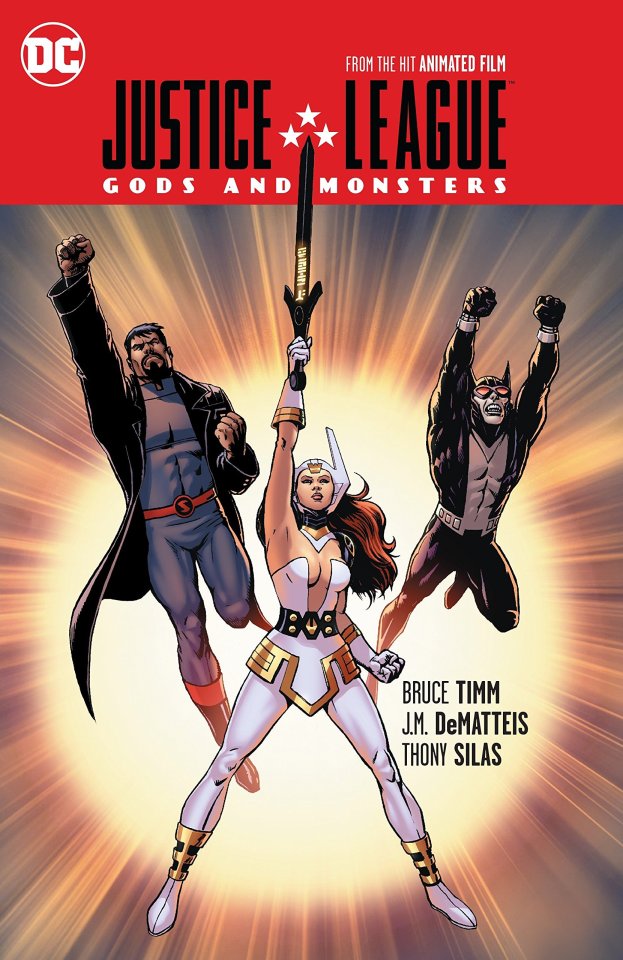
Batman is still a weird figure of the night, and also someone who is connected to the traditional Batman Mythos: Kirk Langstrom who is normally Man-Bat. Not the first time Batman has been a vampire but Kirk being the man under the cowl makes for an intriguing change. For one he's a killer who feeds on criminals in order to sate his bloodlust, but isn't a sadist like most killer Batmen become. While he and Bruce have similar issues with social interaction, Kirk is less messed up emotionally because he isn't motivated by trauma. Telling Tina that he cares for her and won't let any harm come to her is that kind of confession that takes Bruce enormous effort, but Kirk makes it look easy despite his default emotional tone being rather deadpan. While Hernan gets focus as well it's really Kirk who is the main protagonist given he has direct ties to the villain responsible for framing the League, and is the one who takes point investigating the connection between the victims.
In line with her counterparts, Wonder Woman is similarly still a Princess from a utopian society blessed with divine powers. Furthermore she abandons her perfect home because of her love for a man. Unlike Diana however, Bekka is a deity herself, and a New God instead of a champion of the Old Gods. Her "man" is Orion of Apokolips, and it's his death which she helps facilitate that convinces her to break ties with New Genesis and flee to Earth. She's less kill happy than her teammates, or even when regular Diana is waving around a sword, and also less uptight and regal. Sad to say but while I think Timm had good ideas about Bekka, and I would love to see another movie or a series that picks up where this movie leaves her, much like her DCAU counterpart she is the weakest of the Trinity character-wise. Hernan and Kirk get little characters arcs that leave them in different places by the end, while Bekka doesn't change, something she acknowledges herself at the end. Clearly Timm wanted to do more with her which sadly doesn't seem likely to happen.
Far as Elseworlds go I thought this was one of the better ones, certainly a much more nuanced and interesting take than I would've expected from Timm. If we had only gotten the shorts/series he had planned I think this absolutely could be a universe strong enough to support further stories. Definitely recommend it as one of the "good" DC animated movies for anyone looking to kill an hour or two.
#superman#batman#wonder woman#lor zod#man bat#bekka#justice league#justice league gods and monsters#dcau#dc animated movies
39 notes
·
View notes
Text
[RERUN] Holy nostalgia!
youtube
(Thanks to Dark Detective)
[All images are owned by DC Comics and 20th Century Fox Disney. Please don’t sue me]
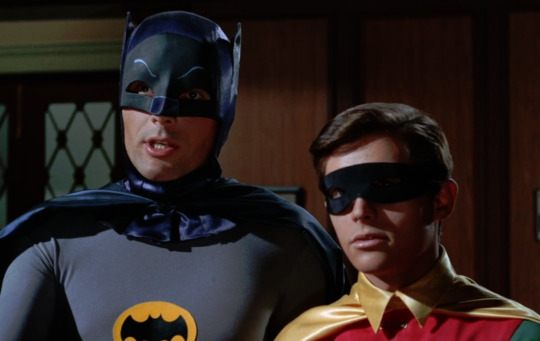
Ah, Batman...campy, goofy, 1966 Batman...
A confession: I am not old enough to have seen Batman in its original run, but I grew up watching it in reruns. I fondly remember it feeling like a comic book with all the BAMs, POWs, CRASHes, and of course ZOWIEs during the fight scenes. Then I hit my teens and early 20s and realized how stupid it was.
Maybe it’s due to hitting my X0s that I can start seeing what they writers and actors were going for. Series creator William Dozier (who also was the narrator for the series) said he never read the comic before being assigned by 20th Century Fox to make a Batman series (something that a lot of the creative staff for DC movies have in common. I’m looking at you Burton, you Donner, and especially YOU, Schumacher!), but he realized that if he wanted to make a series that would appeal to kids as well as parents, he needed to go completely over-the-top!
And over-the-top it was! The problem was that within a few years the comic started steering away from the goofy tone and toward a tone that was more...if not grim then at least more serious. Unfortunately, the series set the tone for what Batman would look like on screen until 1989 (including Casey Casem’s Robin parroting Burt Ward’s “holy” addiction in Superfriends), and the characters were what people thought of when thinking of Batman, the Joker, and the rest until Bruce Timm and Paul Dini redefined Batman’s entire feel in 1992 (only to have Joel Schumacher nearly kill it in 1997)

(Thanks to tenor)
But this isn’t about what Batman became, but what Batman was.
For all the jokes about Adam West’s “square Batman”, the fact that West was the only Batman with a beer-gut, the endless “Holy” exclamations...

...the fact that Cesar Romero would do anything to be the Joker except shave, I do still enjoy the charm of the show, although there are a few glaring issues I have (and most involve the women of the show)

Let’s start with “Aunt” Harriet Cooper. First off, both Bruce Wayne and Dick Grayson are orphans. Neither have any family that could have taken them in (hence why Alfred raised Bruce and Bruce raised Dick after their respective parents’ deaths), so whose aunt is she supposed to be? Plus, she has free reign of the manor (though apparently she doesn’t enter Bruce’s study) Do you mean to tell me she has never heard the Bat-phone going off and wondered why Bruce had a special phone that beeps?

Then we have Barbara Gordon.
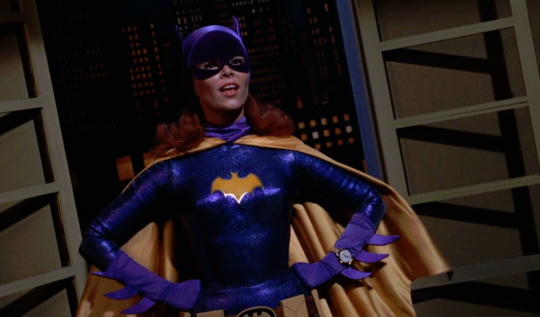
AKA Batgirl.
Now, I get that Commissioner Gordon doesn’t know his daughter wears purple tights and fights crime, but Bruce Wayne is supposed to be the “World’s Greatest Detective” and even he doesn’t know who Batgirl is?!

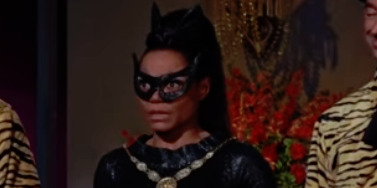

Finally we have Catwoman, who (if you count the movie) was played by three different actresses and no explanation was given.
And now we have the biggest issue I have (that doesn’t involve the women in the show). Batman, Commissioner Gordon, and Chief O’Hara all refer to the GCPD as “the finest police force in the world” (yes, they may be a bit biased) However, Batman repeatedly tells Gordon and O’Hara to keep the cops out of his way. Moreover, when the police are involved, they come off as incompetent.
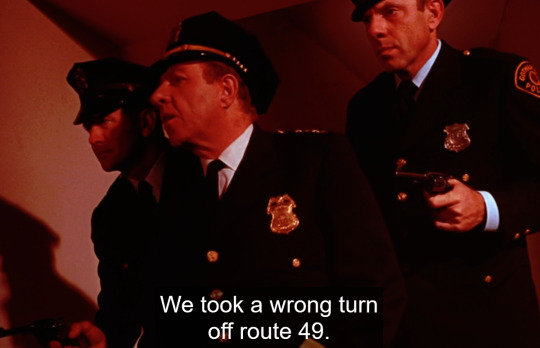
This level of idiocy wouldn’t be seen again until 2012 when Gordon leads the entire goddamn GCPD into the sewers in The Dark Knight! If the GCPD is the finest in the world, the rest of the world must be Keystone!
youtube
(Thanks to laughland)
...no offense to the hometown of the Golden Age Flash...
Once again, if anyone has a favorite episode, let me know!
2 notes
·
View notes
Text
Every Batman Ship Reviewed
Julie Madison: Nobody gives a shit about Julie Madison. Don't pretend you do.
Viki Vale: 5/10. She was done well in the Tim Burton Batman movie, not really anything else. They're alright together but its too vanilla for my tastes.
Selina Kyle: 3/10. Not actively harmful but Jesus does DC over-idolize this ship. They don't go together, that's the point. You only need to watch the first BTAS episode to understand every BatCat story ever. Bruce and Selina meet, they flirt a bit without really diving into the emotional aspect of their characters and how they help each other grow. Bruce and Selina are pitted against each other in some way, usually related to an environmental issue, although Batman writers seem to forget that was the entire reason she was a thief originally. Bruce discovers her identity and he either unhappily sends her to jail or, more likely with later stories, she outsmarts him and manages to actually steal the thing he was trying to stop her from stealing making him look unprofessional and stupid. I actually hate this trope so much that I wrote an entire fic about how when Azrael meets her, he just fucking breaks her wrist, cuffs her, and the story is over because Azrael is actually competent. The best thing to come from this pairing is Helena Wayne. I may be slightly salty because this pairing gets all the limelight and you never see any other relationships besides BruTalia or, if Bruce Timm broke into the writer's room again, BruBabs.
Speaking of which, Talia: 1/10. Jesus Christ, what a nightmare. Just look up any modern storyline involving her and you'll understand why I say that.
Black Canary: 1/10. Step away from Ollie's girlfriend Bruce.
Harley Quinn: 10/10. https://www.tumblr.com/thepiratelordofmordor/695061124450861056/batquinn-and-harlivy-my-perspective?source=share
Kathy Kane: Wait what? I thought they were cousins. I mean I'm no stranger to shipping cousins but I kinda figured we avoided that in canon works. (also the fandom page for Batwoman has a bad habit of just labelling every female individual who claims to be "Batwoman" at some point as Batwoman. That seems counterintuitive but that means that if a character makes a joke about not being Batgirl but instead being Batwoman, she gets a place on the page.)
Lois Lane: 9/10. Just cause I hate the flying boy scout.
Shondra Kinsolving: 1/10. I'm skipping a lot of the most minor relationships because nobody has heard of or cares about the characters but since I'm collecting the Knightfall comic series collections, I actually own the comic she's featured in. Basically the story is fine, if a little sparse on the actual details of their attraction, but what kills it is that, instead of having them break up for any reasons like, oh IDK, being kidnapped by your brother to kill people with psychic powers, the story just gives her brain damage to remove the possibility of a relationship. That's cheap writing and I don't support it.
Wonder Woman: 8/10. I like the idea. This one had some pretty good subtext in Justice League (animated show, 2nd animated show, or movie, take your pick). They'd work well together.
Zatanna Zatara: 8/10. I like them together aesthetically but nobody's ever actually tried to make a story based around these two paired up.
Barbara Gordon: IDK/10. https://www.tumblr.com/thepiratelordofmordor/694586329809485824/brubabs-examination-with-a-hint-of-jokebatsussy?source=share
And now I'm going to bed. Goodnight gentlexen.
7 notes
·
View notes
Text
I can find no proof to back this up, but I swear that I remember an interview with someone involved with Batman Beyond (Dini? Timm? Burnett?) during the first season where they talked about their original plans for a Mr. Freeze cameo.
I distinctly remember that they thought about having a moment where Bruce would go to his freezer to get something and Mr. Freeze’s head would be in there. Alive. And pissed. He’d say something like “Wayne. I will freeze your bones. I will shatter your—” and then Bruce would close the door on him and carry on talking with Terry or whatever.
And like, I’m glad they didn’t do this, naturally. The Mr. Freeze episode of BB we got was one of the series’ best. And poor Victor deserves better than the prospect of being stuck alone and powerless in a freezer for decades. It’s a highly disturbing prospect the more you think about it.
All that said, I’d be lying if I said that some small part of me wasn’t sad that we missed out on a Victor cameo like this:

42 notes
·
View notes
Photo

Batman: Mask of the Phantasm (1993)
In American animation outside of Disney, no other studio inspires as much reverence as Warner Bros. The Merrie Melodies and Looney Tunes shorts precipitated into worldwide recognition for those series’ stock characters. Despite this success, Warner Bros. did not release an animated feature until the musical Gay Purr-ee (1962), in association with United Productions of America (UPA). Animators at Warner Bros. from the 1930-1960s knew they were not making high art, nor were they pretending to. Warners, since the 1930s arguably the most financially stable of the major Hollywood studios, has historically seen little need to bankroll animated features. With that in mind, it might come as less of a shock that Warner Bros.’ first in-house animated feature is Eric Radomski and Bruce Timm’s Batman: Mask of the Phantasm. Originally intended as a direct-to-home media release, Mask of the Phantasm – based on and made by the production team behind Batman: The Animated Series (1992-1995) – transcends those modest intentions. It is among of the best superhero films ever made.
In the wake of Tim Burton’s Batman (1989) and Batman Returns (1992), Batman: The Animated Series, unlike Burton’s efforts, affords time to characterize Bruce Wayne rather than surrendering ample screentime to thinly-written but scene-stealing villains. For that and many other reasons including the looming, vertical art deco-inspired production design of Gotham City; the distinctive and moodiness of its black paper backgrounds; and its balance of dark and lighter tones, BTAS remains a high-water mark among Batman fans – perhaps the best adaptation of the character there is. Mask of the Phantasm builds upon that foundation, in addition to crafting its own unique contribution within the DC Animated Universe (DCAU). As tired as origin stories are, Mask of the Phantasm is part-origin story for the Dark Knight – something largely avoided in BTAS – and somehow integrated here without distracting from the present-day scenes. Rarely is any Batman media a character study of Bruce Wayne, but Mask of the Phantasm proves itself a wonderful exception.
One evening, Batman/Bruce Wayne (Kevin Conroy) attempts to stop a gaggle of gangsters led by Chuckie Sol (Dick Miller) from laundering counterfeit money from a casino. Amid the scrum, Sol escapes from Batman, but immediately confronts a shadowy figure later known as the “Phantasm” in the parking garage – Sol dies in the confrontation. Batman receives the blame for the killing and the concurrent property destruction from Gotham City Councilman Arthur Reeves (Hart Bochner), who just so happened to be profiting from Sol’s racket. Across the film, Bruce reminisces about his courtship with Andrea Beaumont (Dana Delany), their breakup, and the lead-up to the creation of his Batman alter-ego. Juxtaposing Bruce’s past and present, we see how he channels his regrets and profound loss into being Batman. The past haunts him still, overhanging the high roofs of Wayne Manor and the ledges of Gotham’s skyscrapers. Back in the present day, the Phantasm has murdered another crime boss; a third murder involves the Joker (Mark Hamill), initiating an emotional dénouement that, because of the intricacies of motivation that the film develops, elevates the film beyond what might otherwise be sloppy storytelling.
The dramatis personae also includes crime boss Salvatore “The Wheezer” Valestra (Abe Vigoda); Andrea’s father, Carl Beaumont (Stacy Keach); the Wayne family butler, Alfred Pennyworth (Efrem Zimbalist Jr.); GCPD Commissioner James Gordon (Bob Hastings); and GCPD Det. Harvey Bullock (Robert Costanzo).
The screenplay by Alan Burnett (producer and writer on various DC Comics films and Hanna-Barbera productions), Paul Dini (head writer on BTAS and Superman: The Animated Series), Martin Pasko (a longtime DC Comics writer), and Michael Reaves (head writer on BTAS and 1994-1996’s Gargoyles) keep the film’s attention on Batman/Bruce Wayne, despite the introduction of various subplots and Joker – whose somewhat-questionable presence might seem to indicate a project going off the rails. Shadow of the Phantasm’s placement of flashbacks stems the awkwardness that Joker’s inclusion brings, assuring that the film stays grounded into Batman’s psychology. In past Bruce we see a charming young man with time, money, and looks to spare. His romantic side with Andrea is an element of his life, one that connects – inevitably, tangentially – to the trauma his parents’ murder. His most personal motivations – that which a younger Andrea could never see, and privy to only Alfred – are stuck in the past, circulating around that childhood loss.
The occasional reflections from Bruce Wayne on what his life has become make Mask of the Phantasm the most introspective piece within the BTAS continuity, freed from the constraints and expectations inherent of episodic television. No BTAS episode forces its eponymous character to confront himself to such extents. What Bruce Wayne and Batman have become in the present-day treads perilously close not to his style of vigilante corrective justice, but vengeance. The tragic paradox that lies at the heart of this tension is the soul of the Batman mythos. Anyone with the most basic understanding of who Bruce Wayne/Batman and the Joker are will at least have a glimmer of understanding of that paradox. This portrait of what Batman stands for is more maturely handled than any of the twentieth century live-action Batman films, and with less sensational filmmaking than Christopher Nolan and Zack Snyder could produce. But with the film’s screenplay and Kevin Conroy’s iconic voice acting as the Caped Crusader, it becomes an inquest into Bruce Wayne’s tortured soul.
If Mask of the Phantasm ran longer than its seventy-eight-minute runtime, Andrea Beaumont, too, might also have received similar character development as Bruce Wayne here. Even within those seventy-eight minutes, Andrea – with a great assist from Dana Delany’s voice acting (Delany so impressed Bruce Timm here that she was given the role of Lois Lane in Superman: The Animated Series) – is a nevertheless fascinating character. In a cruel irony, her ultimate role in Mask of the Phantasm is to be an incidental mirror to the violence that occurs in this film. Her decision is not an imposition, whether conscious or unconscious, from someone else, but hers and hers alone.
In this drama fit for opera, this Batman occupies a world of operatic proportions. The background and character animation are not as pristine as the best examples of BTAS due to some scattered bits of animation outsourcing. The animation of BTAS might seem stiff and janky to modern viewers expecting Flash hand-drawn animation or hand-drawn/CGI hybrids. However, Mask of the Phantasm retains the gravity-defying art deco of the animated series that somehow does not clash with the ‘90s-influenced and futuristic elements it integrates. Its primary inspirations are of film noir and the Metropolis seen in the Fleischer Studios’ Superman series of short films (1941-1943). The black paper backgrounds provide Gotham’s street corners and rooftops a nocturnal menace, immersing the viewer into the city’s seediness.
Composer Shirley Walker (orchestrator on 1979’s The Black Stallion, conductor and orchestrator on 1989’s Batman) was one of the few women composers in Hollywood at the turn of the twentieth into the twenty-first century. A pianist (she played with the San Francisco Symphony as a soloist while still in high school) who studied music composition at San Francisco State University, Walker would later become one of the first female film score composers to receive a solo credit for composing the music in John Carpenter’s Memoirs of an Invisible Man (1992). But it is her work in the DCAU that distinguishes her – of particular note is her arrangement of Danny Elfman’s theme to 1989’s Batman for BTAS and a wholly original main theme for Superman: The Animated Series. Though Walker could adjust her style to suit a more synthetic sound, she specialized in composing grand orchestral cues. That style was apparent in BTAS and is adapted here from the opening titles (the lyrics here are actually gibberish and are the names of Walker’s music department sung backwards). The foreboding brass and string unison lines seem to reverberate off the animation’s skyscraper-filled backgrounds. Numerous passages in Walker’s score, as if taking hints from Richard Wagner, elect not to resolve to the tonic – setting up scenes where tension escalates alongside the music, forestalling the dramatic and musical release.
youtube
One stunning exception to Walker’s ominous, atmospheric score is the gentle cue “First Love”, an interplay between solo oboe and synthesizer. Bruce’s flashbacks are not only a balm to the grimness of his present situation, but a musical reprieve from the intensity of the action scoring. That Walker can navigate between such differing moods exemplifies her compositional dexterity and overall musical excellence. Walker, who cited Mask of the Phantasm as her personal favorite composition for any film or television production, was one of the DCAU’s greatest under-heralded contributors. And how I wish she was given more chances to score different sorts of films.
Warner Bros.’ last-minute reversal on Mask of the Phantasm’s release strategy – abandoning the direct-to-home media debut for a theatrical release – meant minimal marketing for a low-budget film that made barely a dent at the box office. The film’s home media release would more than make up for the film’s theatrical release failure. Upon the success of BTAS and the critical acclaim lavished on Mask of the Phantasm, Warner Bros. kept the DCAU on television for another thirteen years, with infrequent direct-to-home media movie releases as recent as 2019.
For numerous DC Comics fans, the DCAU is an aesthetic and narrative touchstone. The limited animation is sublime for this period in animation history. In addition, one will overhear fans remaking that a certain superhero’s definitive portrayal might be thanks to the DCAU. The superhero benefitting the most from the DCAU’s characterization and storytelling is unquestionably Batman. And justifiably so, as Mask of the Phantasm shows due respect for Batman and Bruce Wayne – what molded them and how each persona intertwines with the other. The mythos behind any superhero is found not in fight scenes. Instead, it resides in the psychology and rationalizations that forces a person to directly confront another’s wickedness. Mask of the Phantasm realizes that such confrontations test Batman/Bruce Wayne’s remaining vestiges of humanity, and braves to ask moral questions that too many figures of superhero media would rather not think about.
My rating: 8.5/10
^ Based on my personal imdb rating. My interpretation of that ratings system can be found in the “Ratings system” page on my blog (as of July 1, 2020, tumblr is not permitting certain posts with links to appear on tag pages, so I cannot provide the URL).
For more of my reviews tagged “My Movie Odyssey”, check out the tag of the same name on my blog.
#Batman#Batman: Mask of the Phantasm#Bruce Timm#Eric Radomski#DCAU#Kevin Conroy#Dana Delany#Hart Bochner#Stacy Keach#Abe Vigoda#Dick Miller#Efrem Zimbalist Jr.#Bob Hastings#Robert Costanzo#Mark Hamill#Shirley Walker#Glen Murakami#My Movie Odyssey
16 notes
·
View notes